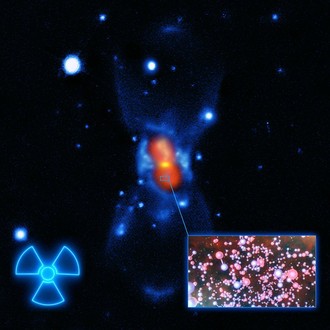
Astronomers have made the first definitive detection of a radioactive molecule in interstellar space: a form, or isotopologue of aluminum monofluoride (26AlF). The new data – made with ALMA and the NOEMA radio telescopes – reveal that this radioactive isotopologue was ejected into space by the collision of two stars, a tremendously rare cosmic event that was witnessed on Earth as a “new star,” or nova, in the year 1670 (it was observed in Gdańsk by Johannes Hevelius in the years 1670 - 1672). 348 years after the initial event was spoted, CK Vulpeculae, remnant of this stellar explosion was observed by an international team, led by Tomasz Kamiński (former PhD student at the Copernicus Center, currently at CfA, US) and including Romuald Tylenda (CAMK, Toruń).
This is the first molecule bearing an unstable radioisotope definitively detected outside of our solar system. Unstable isotopes have an excess of nuclear energy and eventually decay into a stable, less-radioactive form. In this case, the 26-aluminum (26Al) decays to 26-magnesium (26Mg).
Kamiński and his team detected the unique spectral signature of molecules made up of aluminum-26 and fluorine (26AlF) in the debris surrounding CK Vulpeculae, which is about 2000 light-years from Earth. As these molecules spin and tumble through space, they emit a distinctive fingerprint of millimetre-wavelength light, a process known as rotational transition. Astronomers consider this the “gold standard” for detections of molecules.
The observation of this particular isotope provides fresh insights into the merger process that created CK Vulpeculae. It also demonstrates that the deep, dense, inner layers of a star, where heavy elements and radioactive isotopes are forged, can be churned up and cast into space by stellar collisions.
Read more:
* article in Nature Astronomy
* article in arXiv
* ESO press release
* NRAO press release
Picture: Image of CK Vulpeculae, the remains of a double-star collision. This impact launched radioactive molecules into space, as indicated in this artist's impression, which gives a very close-up view of what these molecules look like . The background image was created from a combination of visible-light images from the Gemini telescope (blue), a submillimetre map showing the dust from the SMA (yellow) and finally a map of the molecular emission from APEX and the SMA (red).
Credit: ESO/L. Calçada






